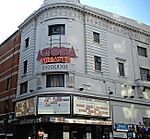Dominion Theatre

The Dominion Theatre is a West End theatre and former cinema on Tottenham Court Road, close to St Giles Circus and Centre Point, in the London Borough of Camden. Planned as primarily a musical theatre, it opened in 1929, but the following year became a cinema—it hosted the London premiere of Charlie Chaplin's City Lights with Chaplin in attendance—and in 1933 after liquidation of the controlling company was sold to Gaumont cinema chain, which later became part of the Rank Organisation. It was a major premiere cinema until the 1970s, when it began to host live concerts. In January 1981 it once more became primarily a live performance venue, and has since hosted many musicals, notably We Will Rock You which ran from 2002 to 2014. It also hosted the Royal Variety Performance seven times in the 1990s and early 2000s. It became a listed building in 1988 and after being saved from redevelopment, was sold to Apollo Leisure Group and subsequently to the Nederlander Organization. In the 21st century it has been extensively refurbished and renovated, including reclaiming spaces that had been turned into offices. On Sundays Hillsong Church London holds services in the theatre.
Excerpt from the Wikipedia article Dominion Theatre (License: CC BY-SA 3.0, Authors, Images).Dominion Theatre
New Oxford Street, London Bloomsbury (London Borough of Camden)
Geographical coordinates (GPS) Address Nearby Places Show on map
Geographical coordinates (GPS)
| Latitude | Longitude |
|---|---|
| N 51.516556 ° | E -0.130139 ° |
Address
Exit 2 - Tottenham Court Road / New Oxford Street
New Oxford Street
WC1A 1HL London, Bloomsbury (London Borough of Camden)
England, United Kingdom
Open on Google Maps






